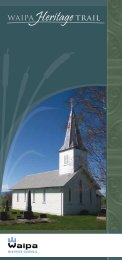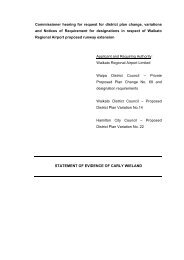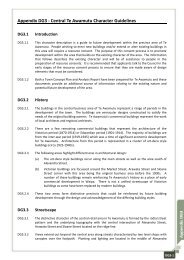Regulatory Committee Agenda - Waipa District Council
Regulatory Committee Agenda - Waipa District Council
Regulatory Committee Agenda - Waipa District Council
Create successful ePaper yourself
Turn your PDF publications into a flip-book with our unique Google optimized e-Paper software.
5.4.3 Summary Cambridge Farmers Club-house<br />
The building interior contains very few architectural references to the CFC phase and how the<br />
club used the building. The lecture room, library and room adjacent to the library have been<br />
stripped of their spatial characteristics and features. The building fabric no longer provides an<br />
opportunity to experience the building as the Cambridge Farmers dub-house. There are<br />
recordable architectural details, as noted in the previous text, that could be used to interpret<br />
the CFC phase of building use.<br />
5.5 Oakleit:h. Wells family (1881-1936)<br />
The Farmers Club annual show went from an attendance of 1000 in October 1877 to a failed<br />
show in October 1880. In 1880 during an economic depression the CFC also faced a dedining<br />
membership. The CFC decided to sell off the dub-house and three acres of land to clear the<br />
club of liabilities and mortgages on the property. Prior to the sale King Tawhiao visited<br />
Cambridge and was allowed to reside at the Farmer's Club (Waikato Times 23 July 1881:2).<br />
On 25 July 1881 the CFC building was sold by tender to Thomas Wells, a Cambridge merchant<br />
and club member. Wells was one of two bidders for the building that submitted the same<br />
tenders. The dub requested Mr Wells and Mr Grice provide new tender offers. The tender<br />
from Thomas Wells was £1355, one pound more than Mr Grice's tender (New Zealand Herald<br />
25 July 1881:5}.<br />
Thomas Wells was a local merchant who owned a large wholesale and retail establishment on<br />
Duke Street. His store stocked draperies, ironmongery, groceries, and agricultural farming<br />
implements (Edgcumbe 1880). In late July 1881 he began the process of renovating the<br />
(former) CFC building and converting the grounds into a garden (Waikato Times 26 July 1881).<br />
The renovation work continued into late August 1881 (Waikato Times 23 August 1881:3). Mr<br />
Wells renamed the building Oakleigh. The residence remained in tile Wells family for<br />
approximately 50 years. Mercer (2009} documented the role the Wells family played in the<br />
development of Cambridge.<br />
Thomas Wells added a gabled bay window to the northern end of the building (figures 4-5),<br />
which is referred to as the Wells addition. The Wells addition is similar in style to other<br />
Victorian houses in the 1880s. It featured a fine bay window and Eastlake stick-style details in<br />
the gable end (figures 4 and 5). The Wells addition to the CFC building is evident on the west<br />
and eastern elevations. Figure 12 shows the east elevation. The Wells additions are also<br />
illustrated on figure 13. The Wells Family lived at Oakleigh and developed the hall and<br />
23<br />
---·····-···---<br />
287






